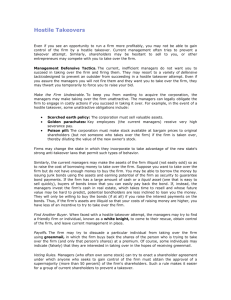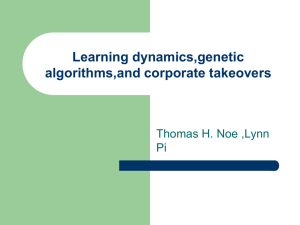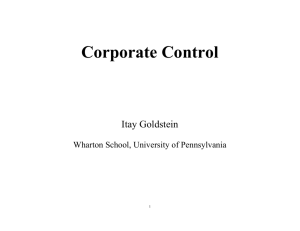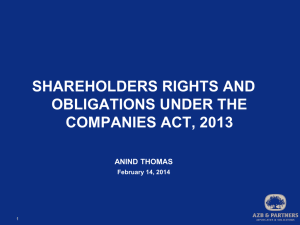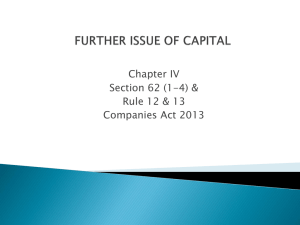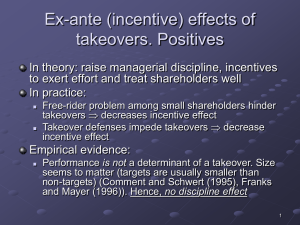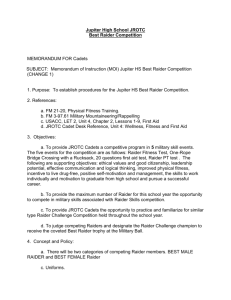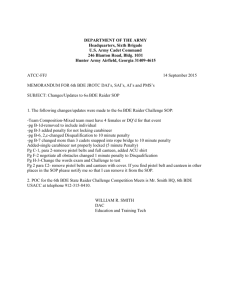TCF-set 6 - Princeton University Press
advertisement
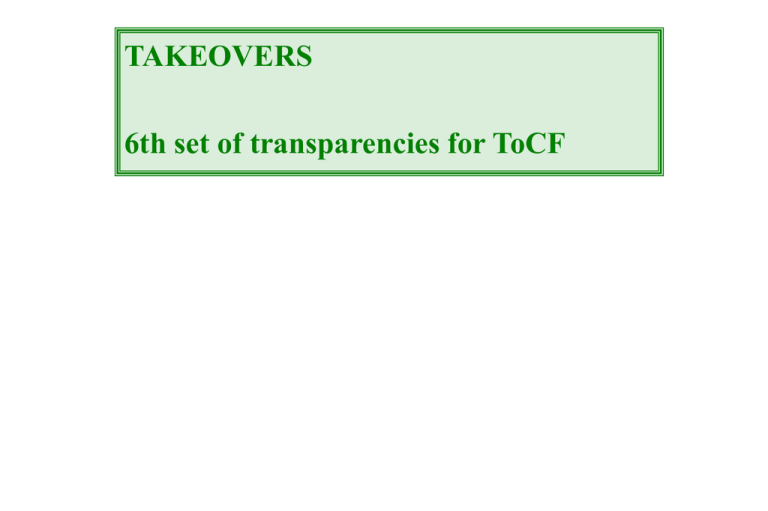
TAKEOVERS
6th set of transparencies for ToCF
Market for corporate control
US merger mania in 80’s.
Europe: 2000 hostile takeover of Mannesmann.
2001: Germany opposes EU proposed directive to stop managements from
using poison pills.
Response to failure of internal control (“if current management fails to maximize
investor value, takeover will replace management”)?
Gains: target shareholders 30%
acquiring co 0 % (hubris? free riding?...)
other constituencies?
(workers, consumers,...)
2
Golden parachutes
Takeover defenses:
– greenmail (targeted repurchases
raider
stock price falls)
– poison pills
– restrictions on inalienability of stocks
(need approval of board)
– staggered boards
– supermajority amendments
– fair-price amendments
– dual class votes
– threat of litigation
3
I. PURE THEORY OF TAKEOVERS
Future appearance of unknown
raider who values firm more
otherwise: option
(Verizon/Genuity, DB)
Raider appears
Initial
investment,
borrows
I-A
Possibly: investments by
entrepreneur
raider
takeover
No takeover
value v to investors
incumbent gets w
Example
Reasons for takeovers:
good idea, better fit,...,
synergy with other firm,
private benefit from control.
4
EXTRACTING RAIDER SURPLUS:
TAKEOVER DEFENSES AS MONOPOLY PRICING
In tradition of
Diamond - Maskin 1979
Aghion - Bolton 1987
Point: future buyers not at the table initially
{initial investors, entrepreneur} pair has monopoly power over
sale.
can pay
Assumptions Raider not credit constrained
known, but
density
A large
entrepreneur not credit constrained
5
Suppose can commit to sale price P
can commit to cutoff
or
6
But “can’t commit” : see later.
INCENTIVE TO PREPARE RAID
Cost c of acquiring information: For cutoff
may lead to reduction in
INCUMBENT ENTREPRENEUR CREDIT CONSTRAINED
where
7
If (1) satisfied for
no change.
Otherwise ( A small )
(a)
shadow price of (1)
(b)
NPV-pledgeable income tradeoff once again
8
UNKNOWN VALUE ENHANCEMENT
(
with
measurable ex post)
Observation: package sale not optimal,
partial sale = metering device.
Example:
and
independent.
no credit constraint.
Thought experiment:
known:
9
unknown: keep 50% of shares,
charge P for block,
purchases iff
10
II. POSITIVE THEORY
Looks at common institutions
Suppose • single bidder
• tender offer
likelihood of takeover.
restricted or not (# of shares)
conditional or not (on majority stake).
Suppose • equal voting rights
• needs fraction
to take control (to deliver
and
).
Def: INVESTOR VALUE ENHANCING RAIDER:
INVESTOR VALUE DECREASING RAIDER:
11
VALUE ENHANCING RAIDER: (Grossman-Hart 1980)
Continuum of shareholders.
Unrestricted, unconditional offer
probability of success
suppose
then better off holding on to share:
(in the absence of private benefit from control:
).
12
If private benefit from control
Toehold:
positive
if
raider
surplus
and
Dilution : can dilute fraction
of gains made by
shareholders who have not tendered – if gains control
13
TAKEOVER DEFENSES
Example: flip-over plan (holders of shares are allowed to purchase new
nonvoting shares at substantial discount after a hostile
takeover)
shares kept (50%) worth
shares acquired (50%) worth
Assuming
(otherwise no takeover)
14
PIVOTAL TENDERING
(Bagnoli-Lipman 1988, Holmström-Nalebuff 1992, Gromb 1995)
n shares, cash flow right 1/n.
a n have voting right
k a needed for control
(a) CONDITIONAL OFFER (+ UNRESTRICTED)
P=
raider gets
(entire surplus)
(b) NO CONDITIONAL OFFER
1 share / shareholder
Wlog: raider does not bid for B-shares (“no trade”).
A-shares: mixed strategy equilibrium (others, e.g., “k tender; others don’t”)
Shareholder i = m-i shares tendered by others.
Also
A-shareholders get
each.
15
Expected value enhancement on voting shares:
16
For a large, can show
(GH)
Intuition
very unlikely
Want one share-all votes!
17
Multiple shares / shareholders:
divide each share into N shares ( aN voting shares,
kN needed for majority )
# of shares tendered
0
tenders for sure
a
randomizes on
only one share
N
don’t tender
a shareholders
support of distribution at most a. If bounded away from
1, then can make sure takeover succeeds by tendering a more shares
extra profit on inframarginal shares.
18
Discussion
Noise is here endogenous (mixed strategy). Introduction of exogenous noise
(e.g., Segal 1999: pr (a shareholder cannot respond to offer) = ) resurrects
Grossman and Hart's free-riding result. Each shareholder is too unlikely to be
pivotal.
Segal's other argument: even if shareholder turns out to be pivotal, discontinuity
posited by model overpredicts impact: intensity of monitoring, shareholders'
payoff under managerial authority, etc. move more continuously. Furthermore,
share acquisition may occur over time.
19
VALUE DECREASING RAIDER
DS to tender
coordination problem
Coordination or unanimity rule will do.
But does not capture
Suppose A shares
B shares (no interest to raiders).
Would like raider to buy as many shares as possible:
ONE-SHARE-ONE VOTE
20
